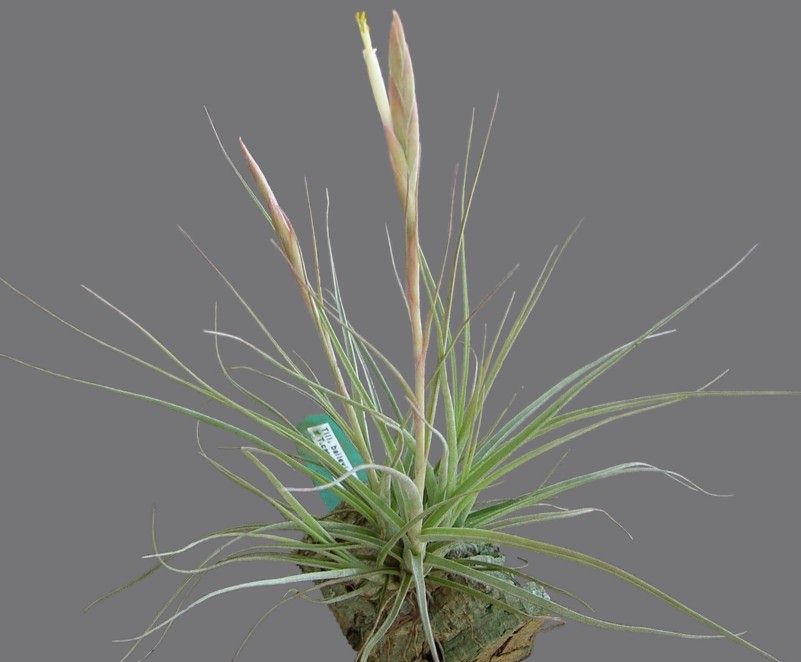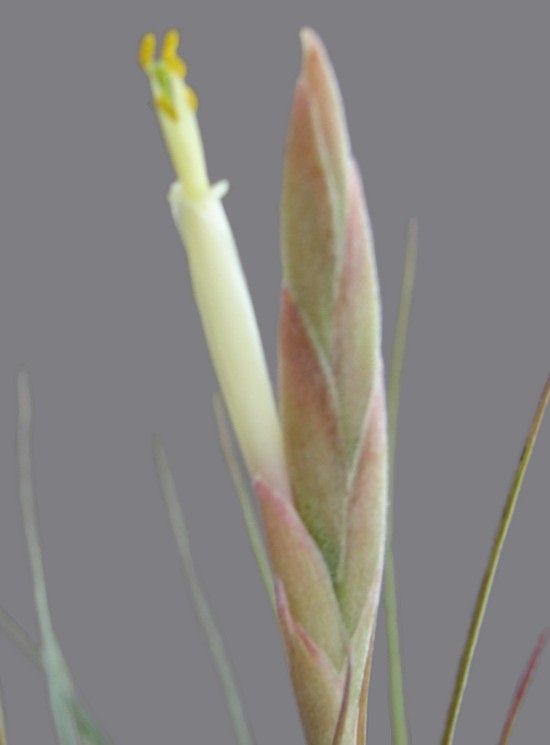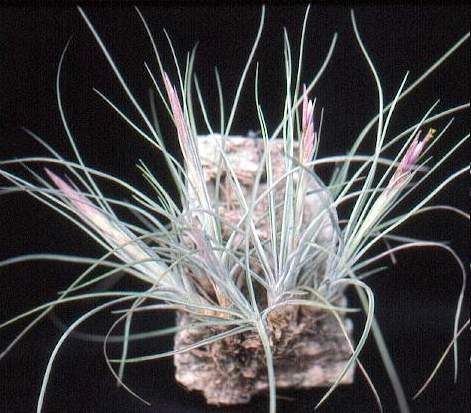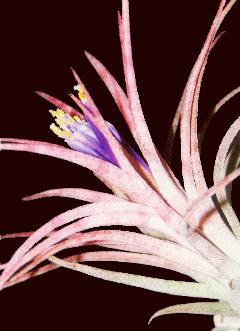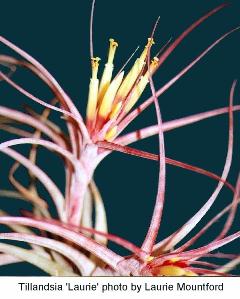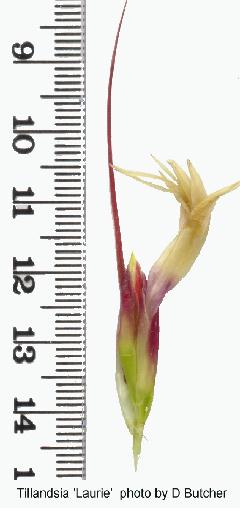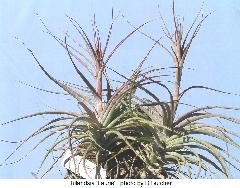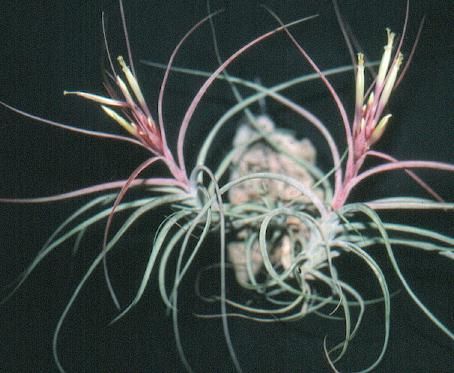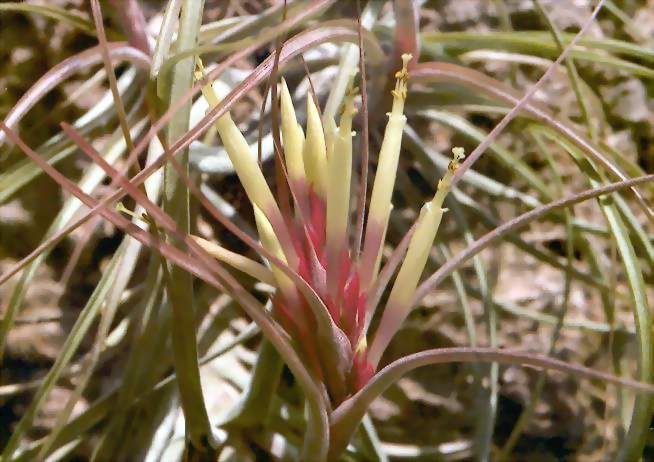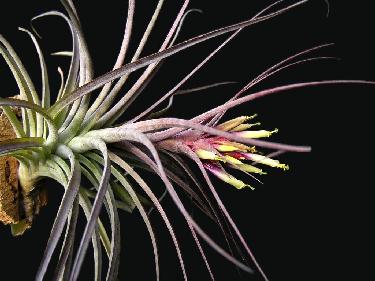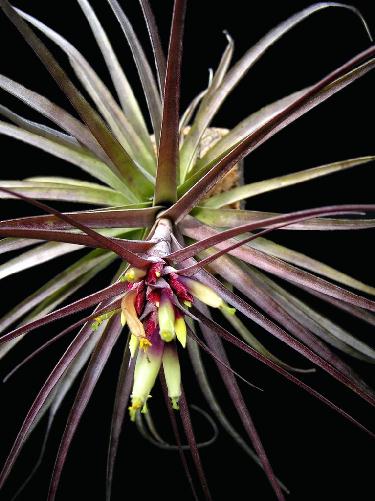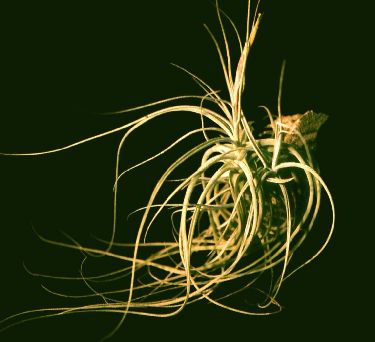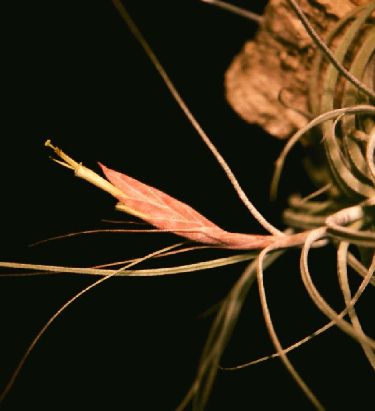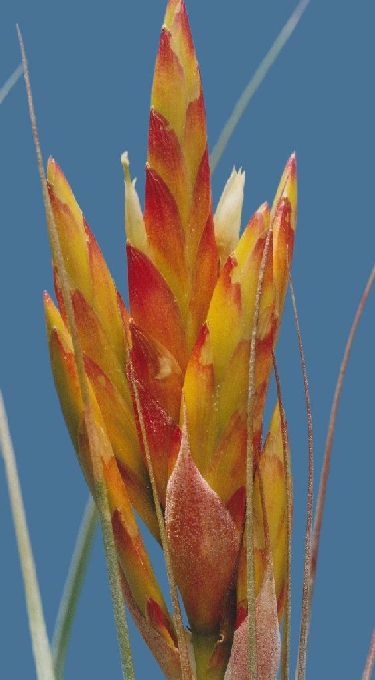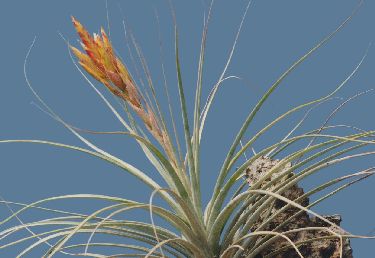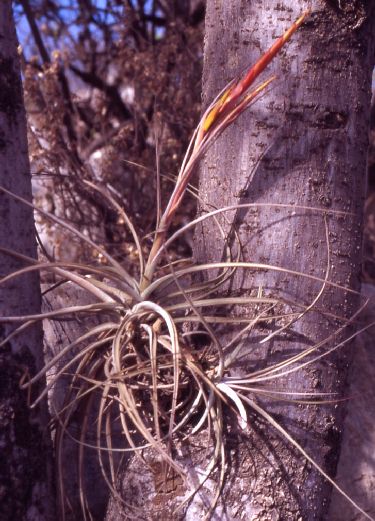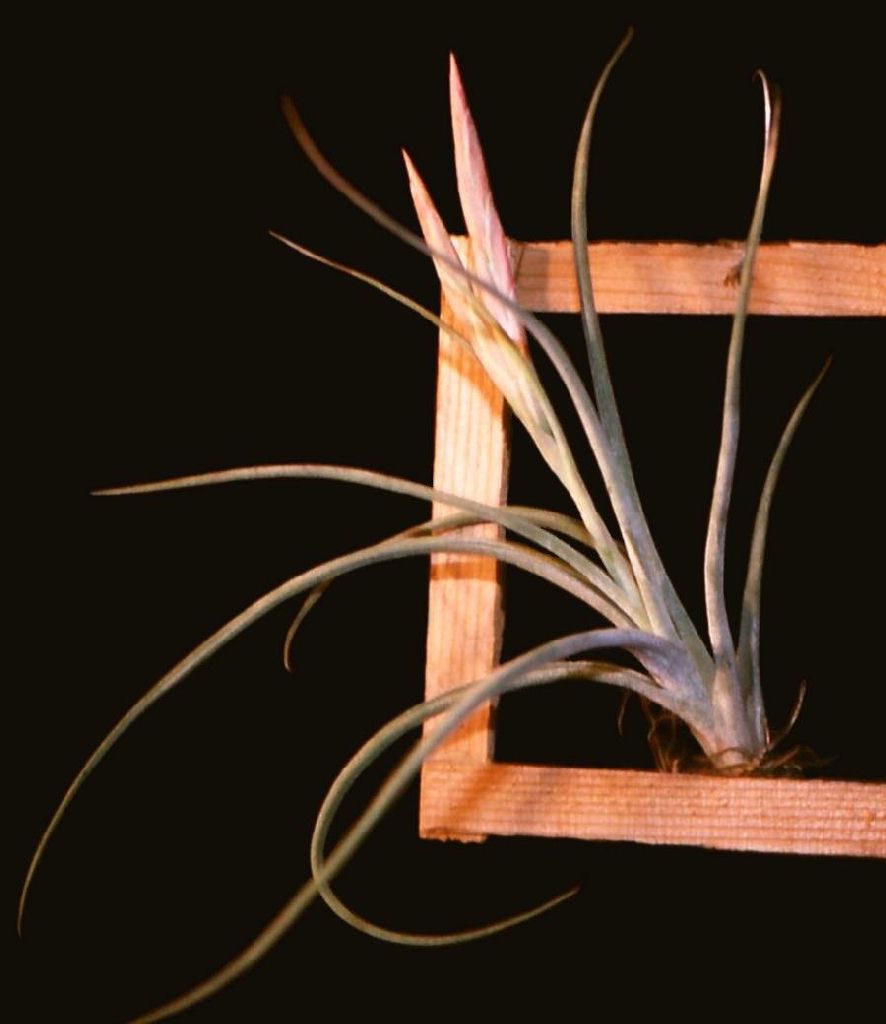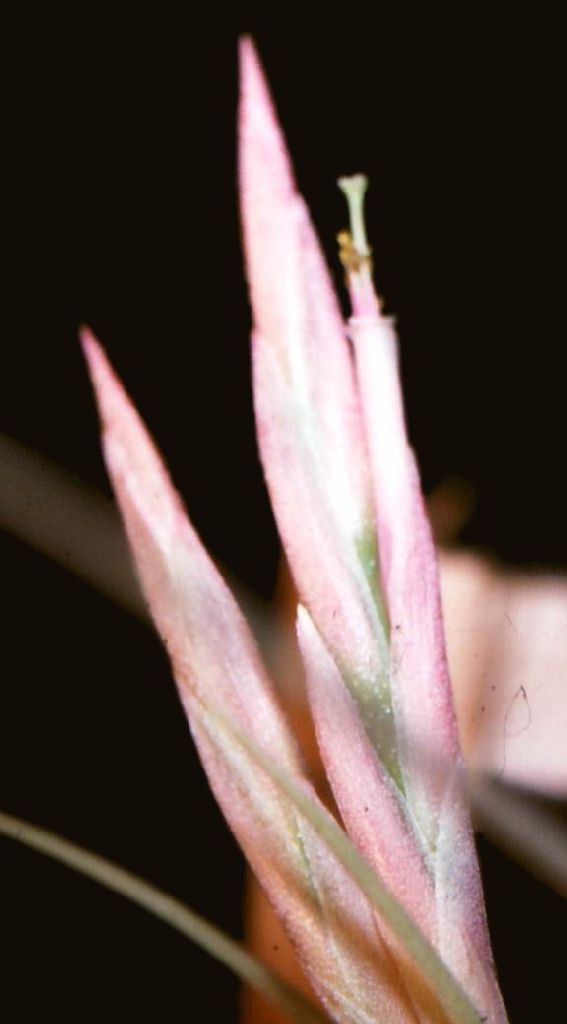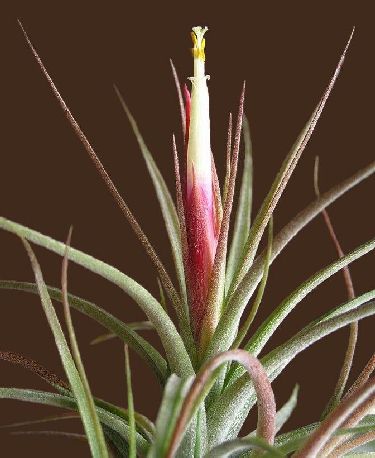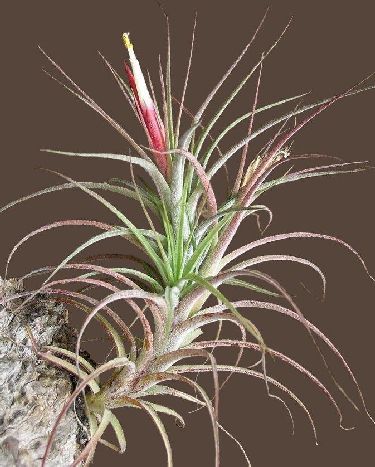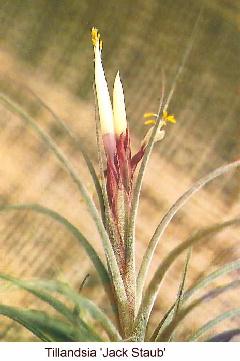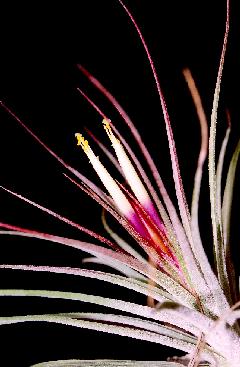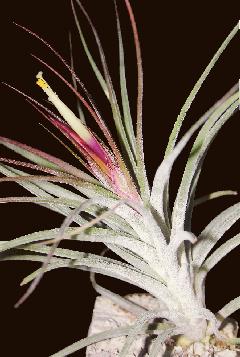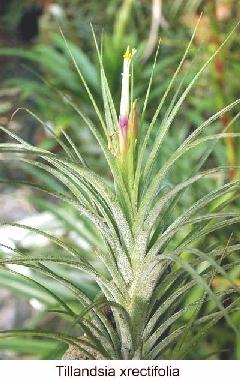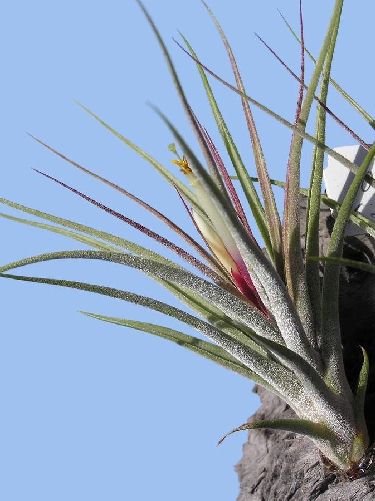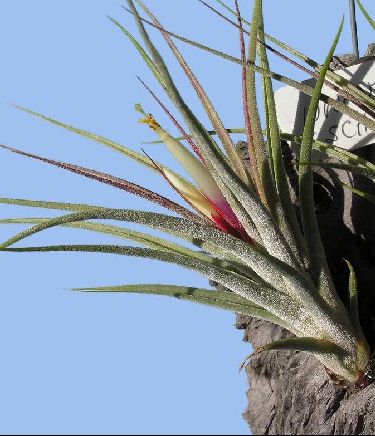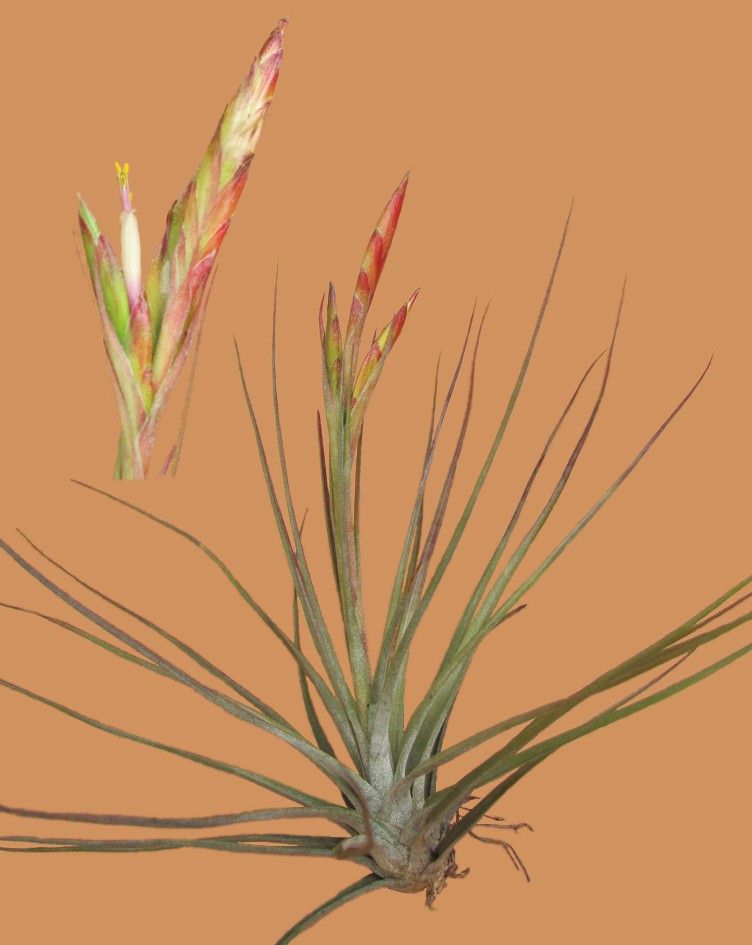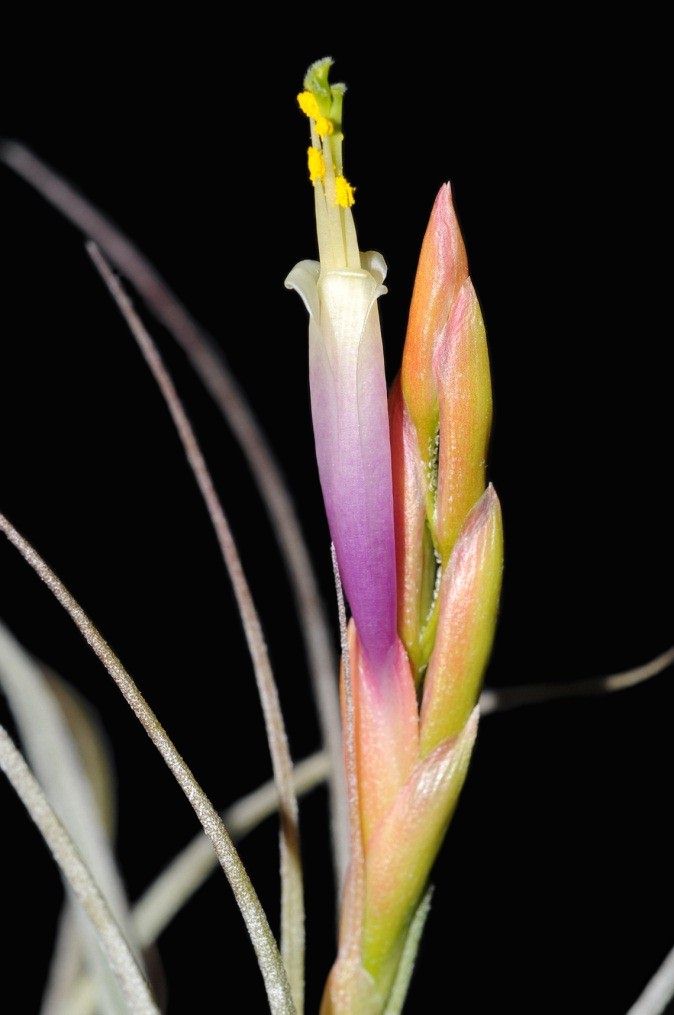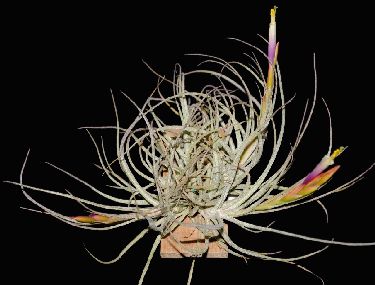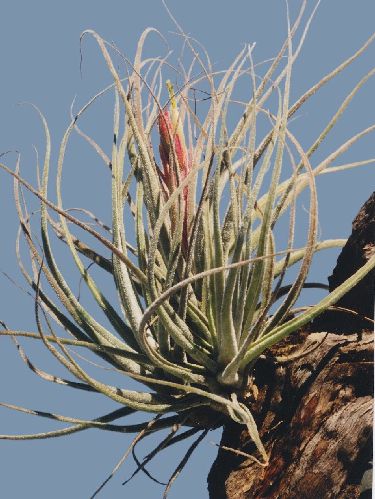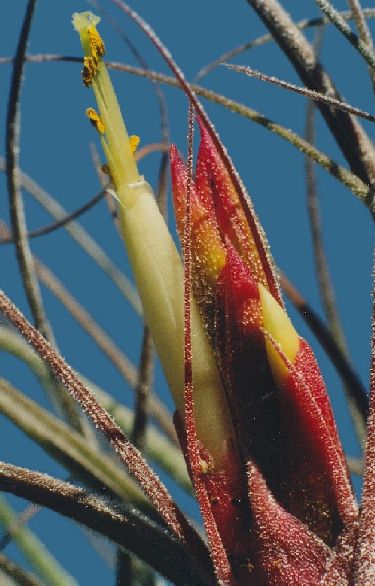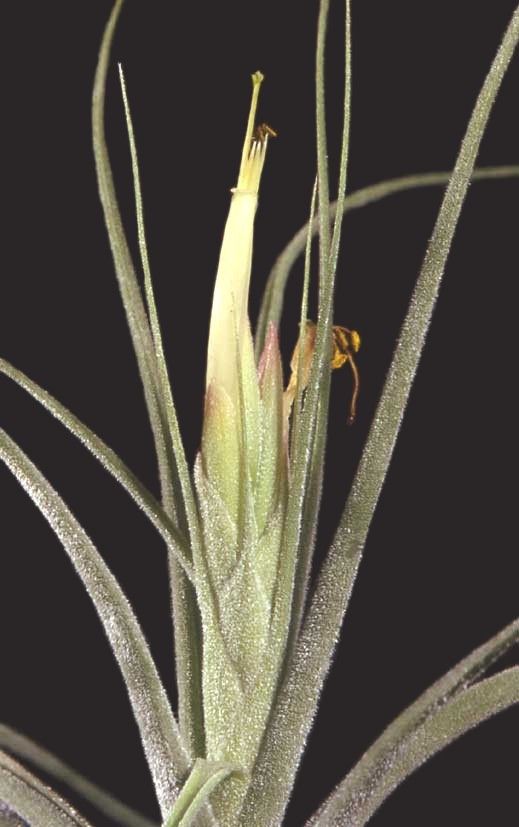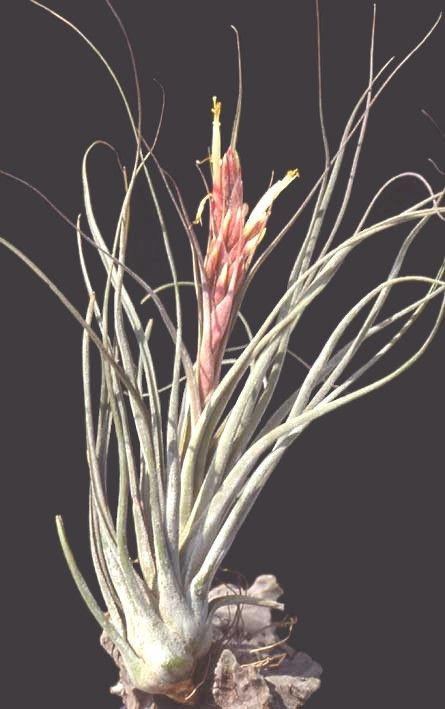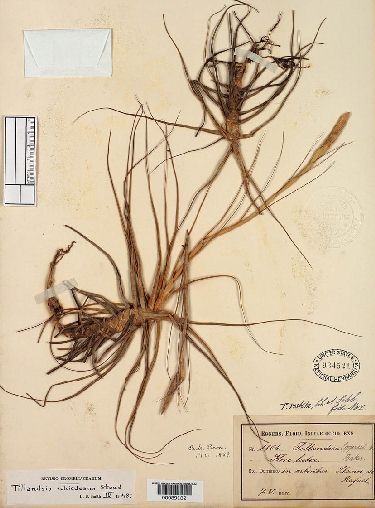
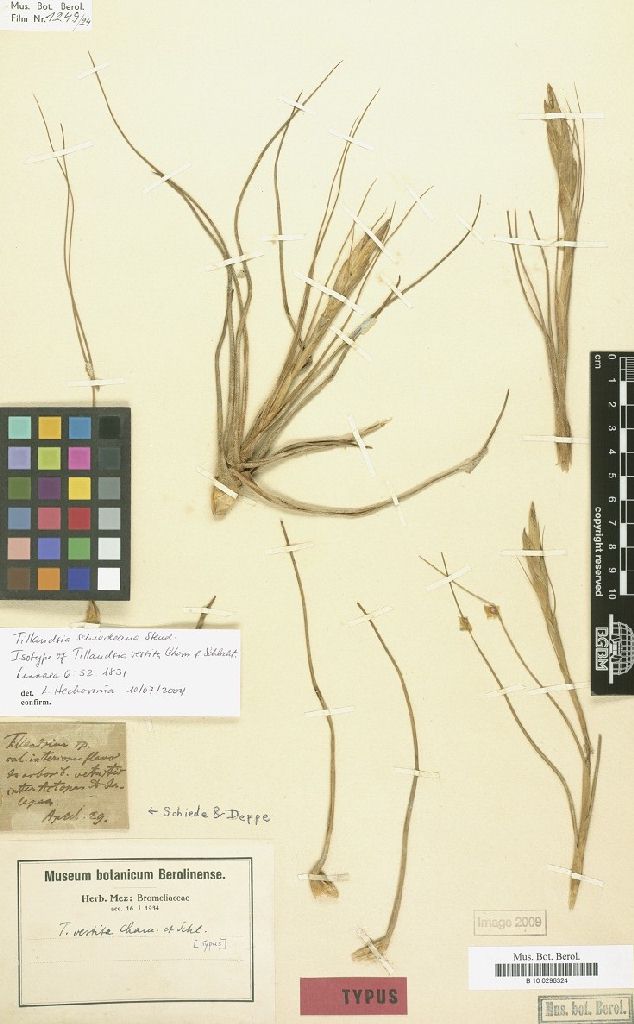
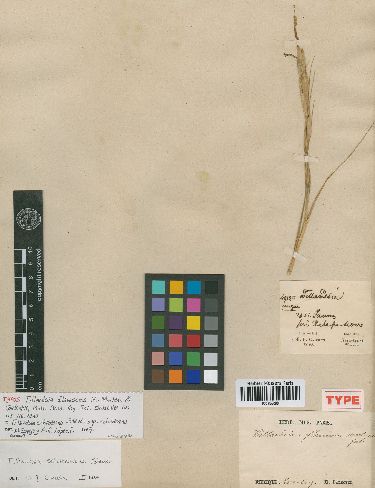
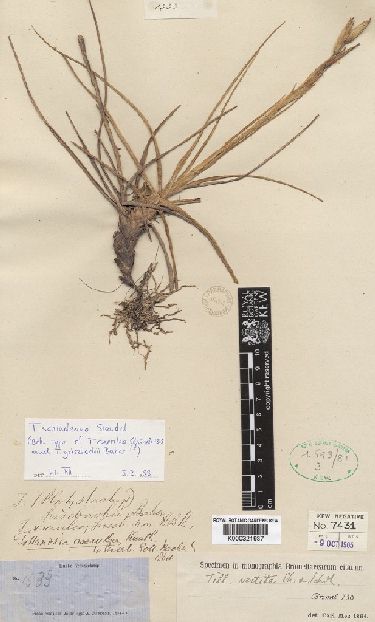
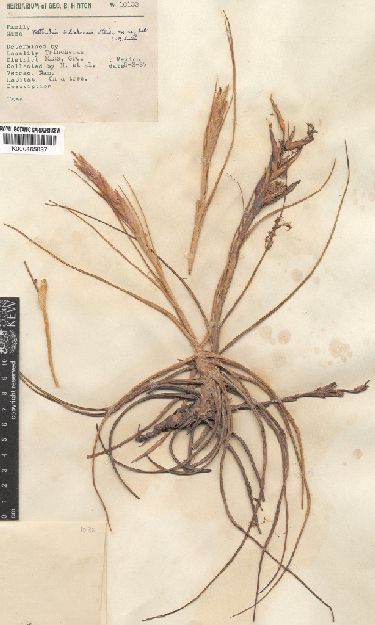
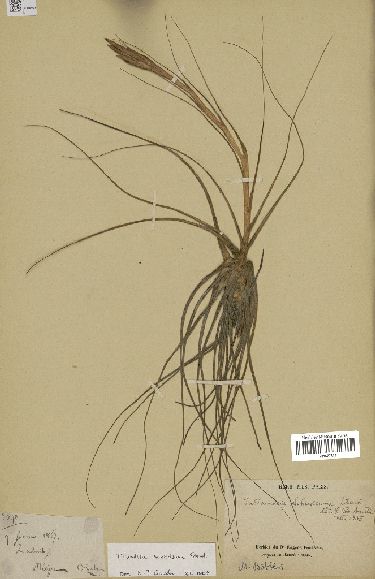
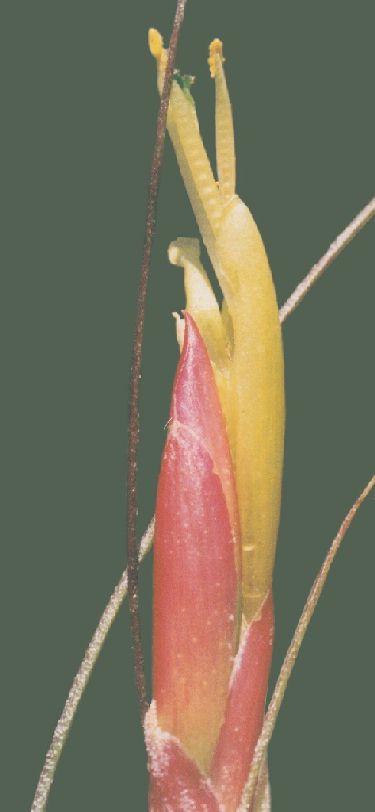
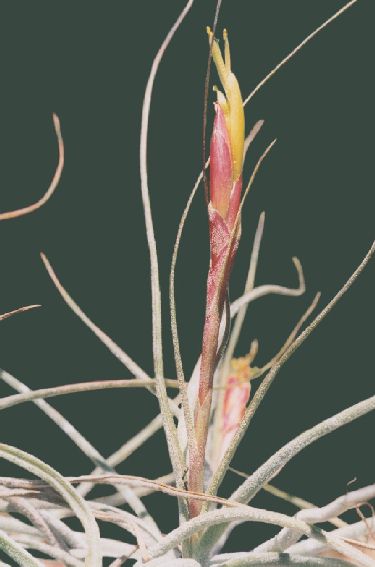
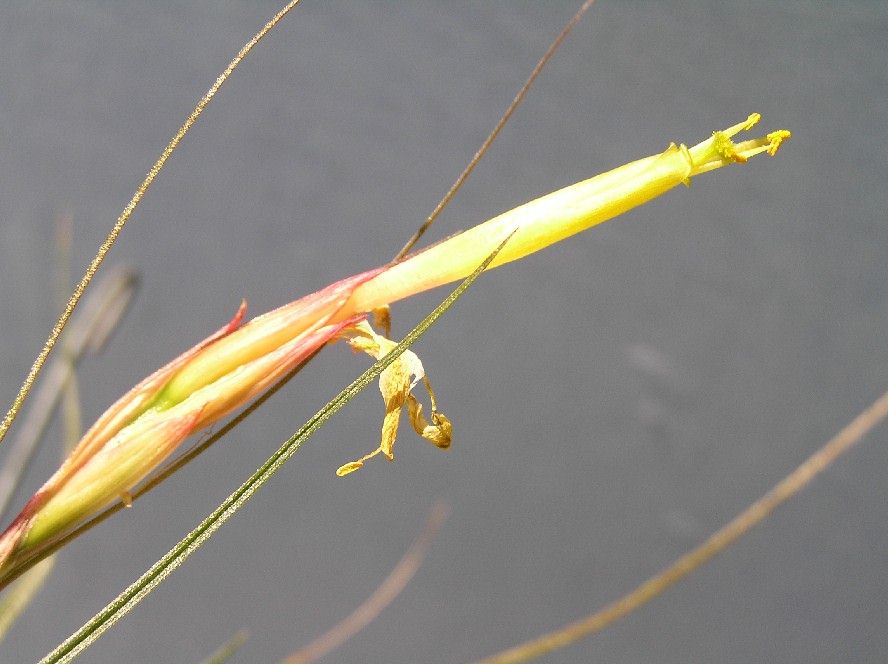
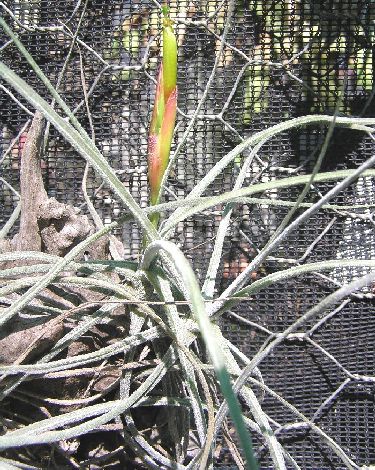
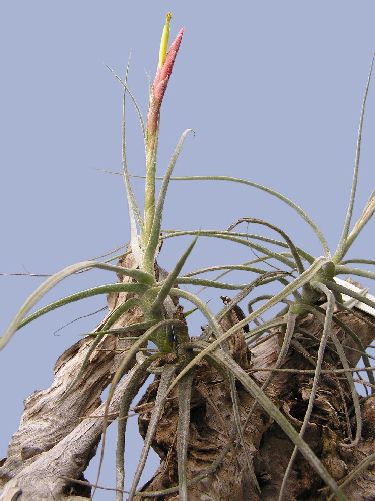
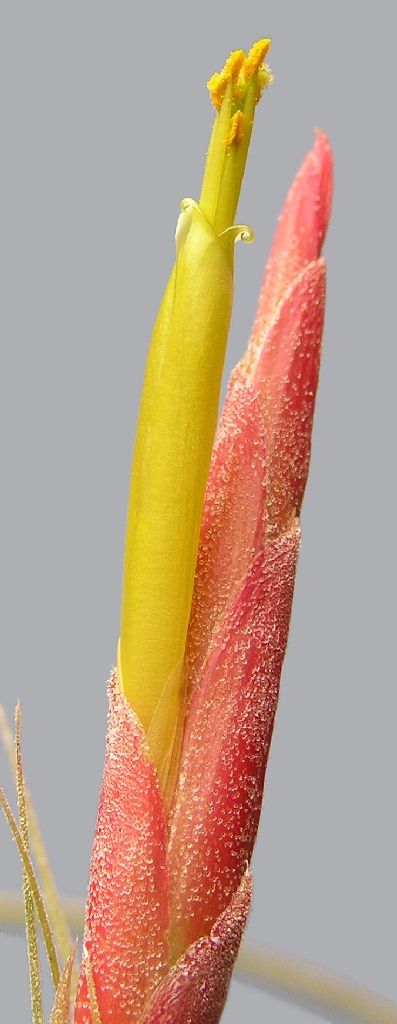
First let me introduce you to Dr Wilhelm Schiede a German Botanist who thought he would make his fortune by joining Ferdinand Deppe in collecting all manner of Mexican animals, plants and artefacts for the insatiable European market. Alas, he was only in Mexico for two years in 1828-9 before dying in 1830. Both did not do well in the riches category but both had tillandsias named after them.
In 1889 in Baker’s Handbook of Bromeliaceae, growers had three species to choose from, namely, T. eggersii, T. vestita, and T. grisebachii. [P1-6 HERBARIUM SPECIMENS] The last named is an odd one because this had been previously named T. caerulea by Grisebach and perhaps Baker could not understand how such a plant got a name suggesting blue. I cannot find out the reason either so I leave you to ponder!
In 1935 Mez in Das Pflanzenreich we see only one name to deal with, namely T. vestita.
In the same year Lyman Smith decided that T. vestita had to be replaced by T. schiedeana because of an earlier homonym. This meant that T. vestita had been accepted for 104 years and T. schiedeana has only been with us for 76 years.
A review of all the old descriptions shows that, when mentioned, that floral bracts have a rosy hue and petals are yellow or greenish yellow.
According to the records in Smith & Downs T. schiedeana [P7-12 PHOTOS OF A RANGE FOR THE SPECIES] can be expected between altitude 50 – 1800m in the following countries, Belize, Colombia, Costa Rica, Dominican Republic, El Salvador, Guatemala, Haiti, Honduras, Jamaica, Mexico, Nicaragua, and Venezuela. In Mexico it does not seem to occur above 25°N.












Everything went smoothly until Foster and Van Hyning found a plant in 1957 [P13 HERBARIUM SPECIMEN] near Tequisistlan in the District Tehuantepec of Oaxaca. This was described by L B Smith in Phytologia 6: 83, 1958 as T. pueblensis var glabrior where the terse description says “Differs from T. pueblensis by having floral bracts soon glabrous”. One would assume that the petals were blue in line with the type species. Alas, Gardner tells us that the description was based on a few dried specimens.
In 1981 Renate Ehlers found a plant near Totolapan in the district of Tehuantepec of Oaxaca and in conjunction with Weber published the name T. schiedeana var totolapanensis. [P14 DRAWING] Their diagnosis was that it differed from the type by having leaves secund, arcuate recurved and clearly fleshy succulent, much shorter than the inflorescence. BUT they also gave a full description. Petals were unknown but fragments indicated red spotted. The 1980’s was when C.S. Gardner was doing a review of Mexican tillandsias and had strong views in sorting them according to floral attributes. She saw that Smith’s “var. glabrior” was closer to a T. schiedeana and this was what she said in Selbyana 361-379. 1983
“Tillandsia schiedeana var glabrior (P 15-17 PHOTOS) is the correct name for an attractive small tillandsia that is well represented in the trade and bromeliad collections around the world. This subspecies occurs in large colonies on perpendicular canyon walls from Tequisistlan to Totolapan in the state of Oaxaca, Mexico at 900 to 1200 meters.
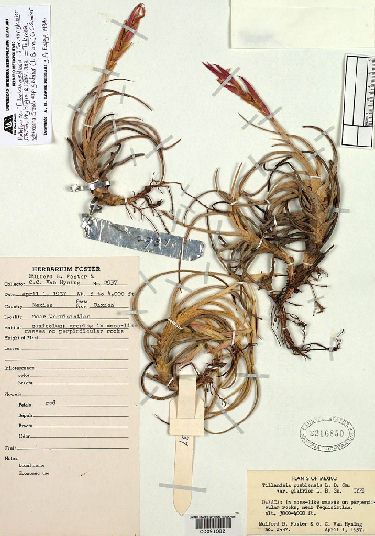
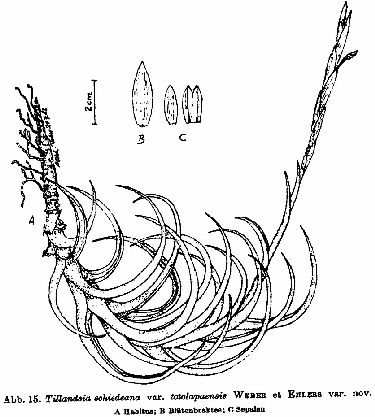
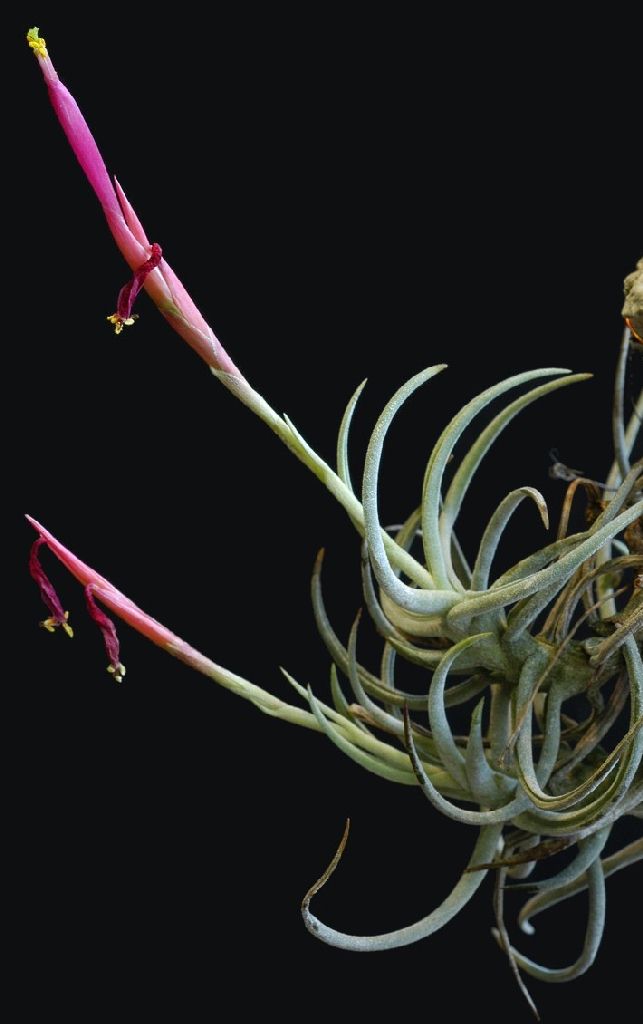
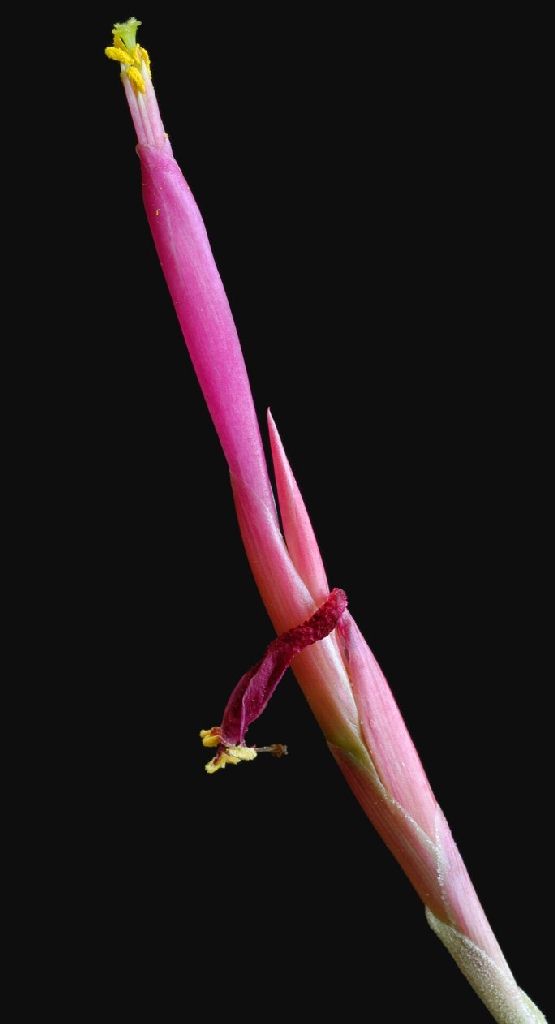
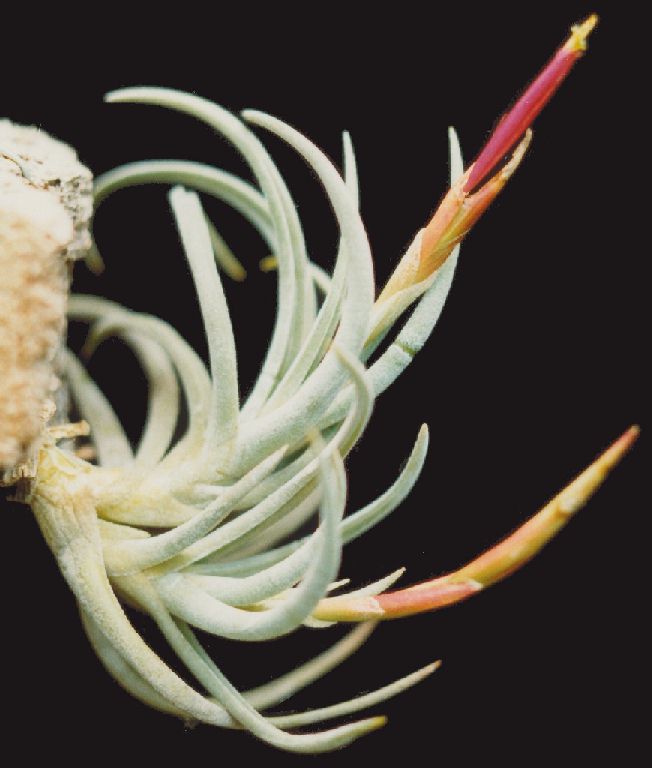
Dr. Lyman B. Smith described this plant originally as T. pueblensis var . glabrior from a few dried specimens in 1958. Without fresh flowers, the plant, with its thick, curved, gray-lepidote leaves and small, simple spike, appears similar to T. pueblensis. In 1983, Wilhelm Weber and Renate Ehlers described this same plant as Tillandsia schiedeana var. totolapensis (See below) from a living specimen collected in Mexico. Since Dr. Smith's varietal name has precedence it must be conserved even though the species epithet is corrected.
Although this subspecies is more closely related to T. schiedeana than to T. pueblensis, it is distinct from the former by several significant characteristics, most of which are associated with saxicoloy. For example, it forms large clumps of a single clone, and individual rosettes have both long, descending stolons and thick, upwardly secund leaves. These characteristics are often found in saxicolous species including T. pueblensis.
Tillandsia schiedeana subsp. schiedeana is widespread, and occurs from northern Mexico to northern South America. Specimens of this subspecies also occur sympatrically with subsp. glabrior. Specimens of the typical subspecies occur also in saxicolous forms. They do not, however, display modification of the typical spherical clumps of stellate rosettes with straight leaf blades joining the leaf sheath at a 90 degree angle. Similarities in inflorescence characteristics of the two taxa support conspecific classification, however, assignment to different subspecies indicates a greater difference than varietal classification does.
Pigmentation of the flowers varies between and within the two subspecies. A larger amount of red pigmentation is typical of the petals of subsp. glabrior with one-half to all of the petal lobes red, whereas in samples from six populations of the typical subspecies only a few specimens in each were found to have a small amount of red pigment at the base of the primarily yellow petals.” (P 18-19 PHOTOS)
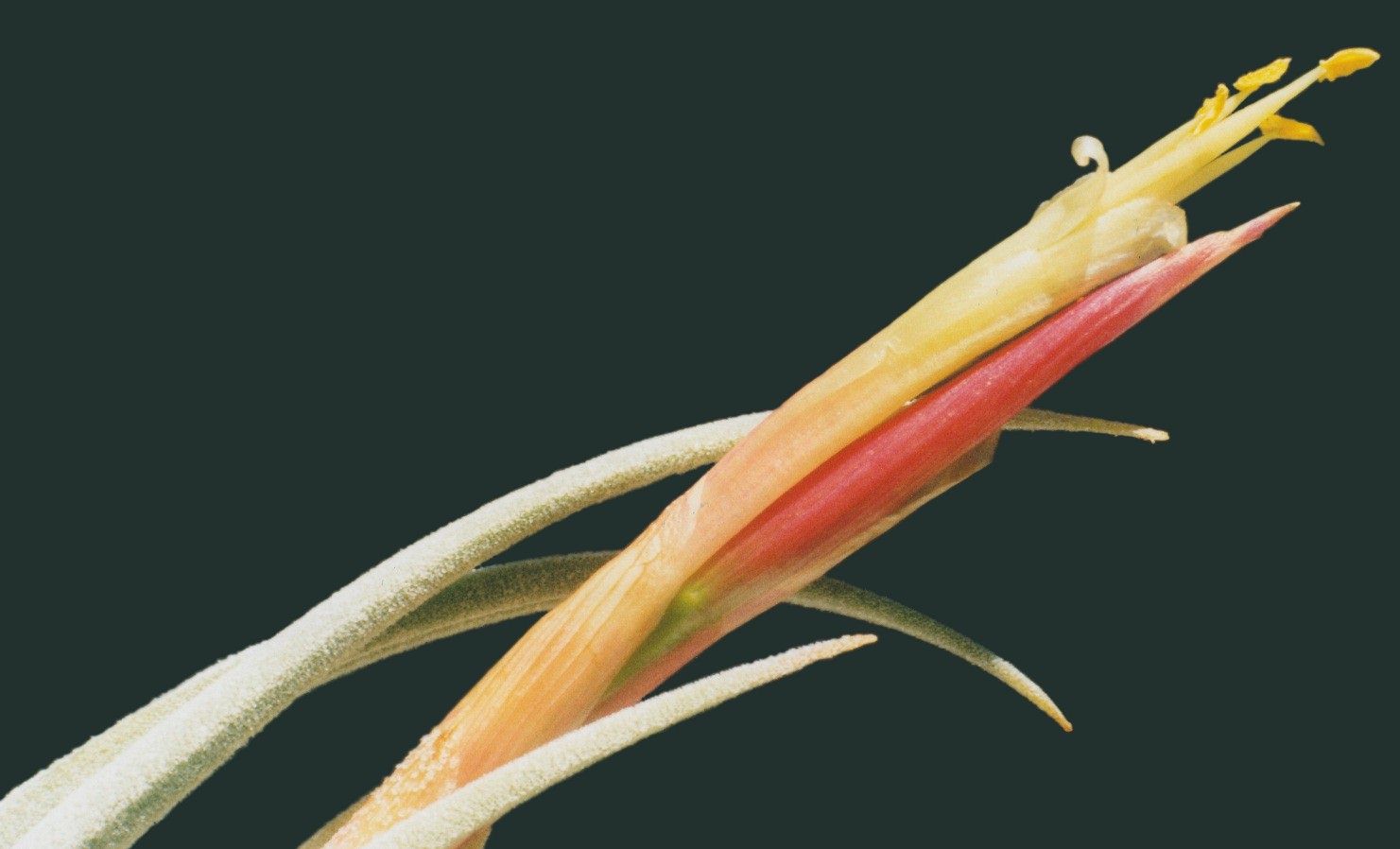
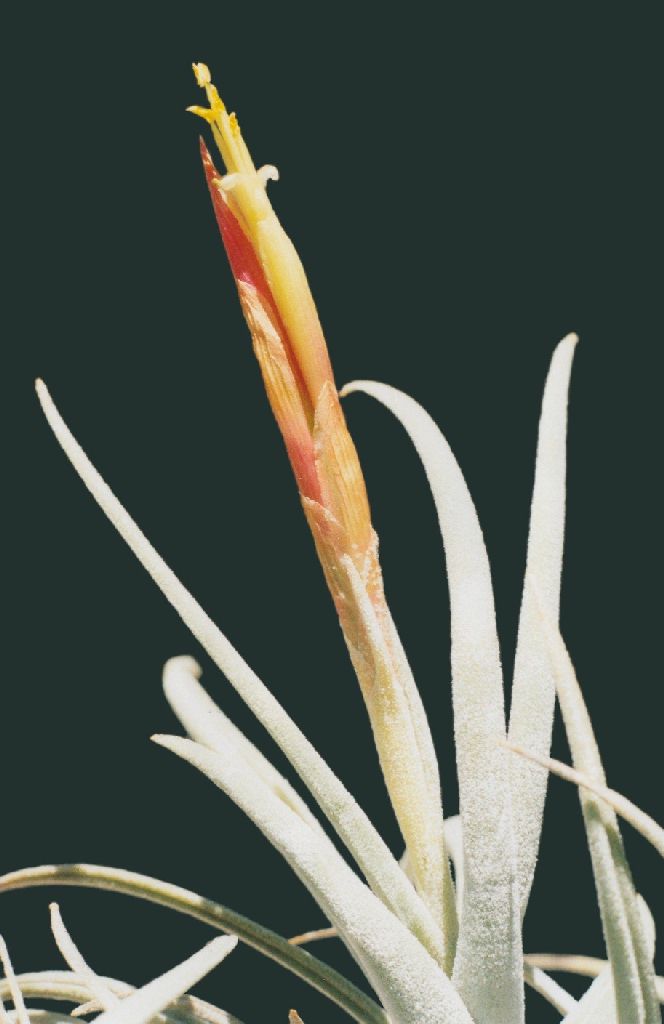
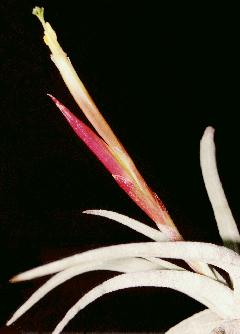
In Selbyana 25(1); 60. 2004 in a Checklist of Mexican Bromeliaceae by Lopez-Ferrari, Espejo & I. Ramirez we see Tillandsia glabrior (L.B. Sm.) Lopez-Ferrari, Espejo & I. Ramirez, comb. et stat. nov. But we see no attempt to describe this taxon promoted to species status so we are in the dark as to its floral attributes.
In trying to come to terms with this lack of information I have used the ICNCP rules to try to solve problems occurring in plants in this group in cultivation where collection data is missing. Perhaps the taxonomists are not prepared to investigate the possibilities of natural hybridization as suggested by Gardner’s findings. If we look at Acta Bot Mex 81: 71-147. 2007 “Bromeliad Flora of Oaxaca” we see that T. glabrior is endemic to the districts Tehuantepec and Tlacolula BUT we see that T. schiedeana can also be found in these districts.
If a ‘true’ T. glabrior had red petals then it is feasible that natural cross pollination is occurring causing the observation in horticulture that plants that look vegetatively like T. schiedeana can have a combination of red and yellow petal colours. Conversely you can have plants that look vegetatively like T. glabrior with the same odd petal colour depending on how back crossing occurred.
Let us now look at cultivars of T. schiedeana.
Everybody knows that the ubiquitous T. schiedeana always has yellow petals and reddish tones to its floral bracts - at least this is what all the taxonomists tell us. Because Barry Genn in Qld, Australia, has plants with yellow bracts we both feel they need a cultivar name. There are two forms - thin leafed (blade 2mm diam at thickest) and fat leafed (blade 5mm diam at thickest). Because they don't blush in the floral bracts they must be ultra shy - hence the two names 'A Little Shy' for the smaller plant and 'Shy' for the larger plant. Apparently Nev Ryan knew about these in the 1990's or before and now Barry has proved that they reproduce faithfully from self set seed. (P 20-22 PHOTOS)
Renate Ehlers reports that the form with yellow floral bracts is not rare in Mexico, having found it in many locations, most times in low and humid areas. Eric Gouda also reports the same sort of occurrence in Colombia.(P23 PHOTO) There is a form with orange floral bracts but seems to be fairly rare at the moment and is informally called ‘Orange Bracts’. (P 24, 25 PHOTOS)
This shows that this species is wide spread and very variable in plant size and furriness of the leaves but nothing is said that the floral bracts can be greenish-yellow to yellow, even in the descriptions of the synonyms. In a way it is odd that you see ‘Major’ and Minor’ in Nurserymen’s lists and yet there appears to be a variation of sizes in the wild. But then conversely no names have been given because of difference in floral bract colour and yet apparently this trait has been noticed in the ‘Trade’.
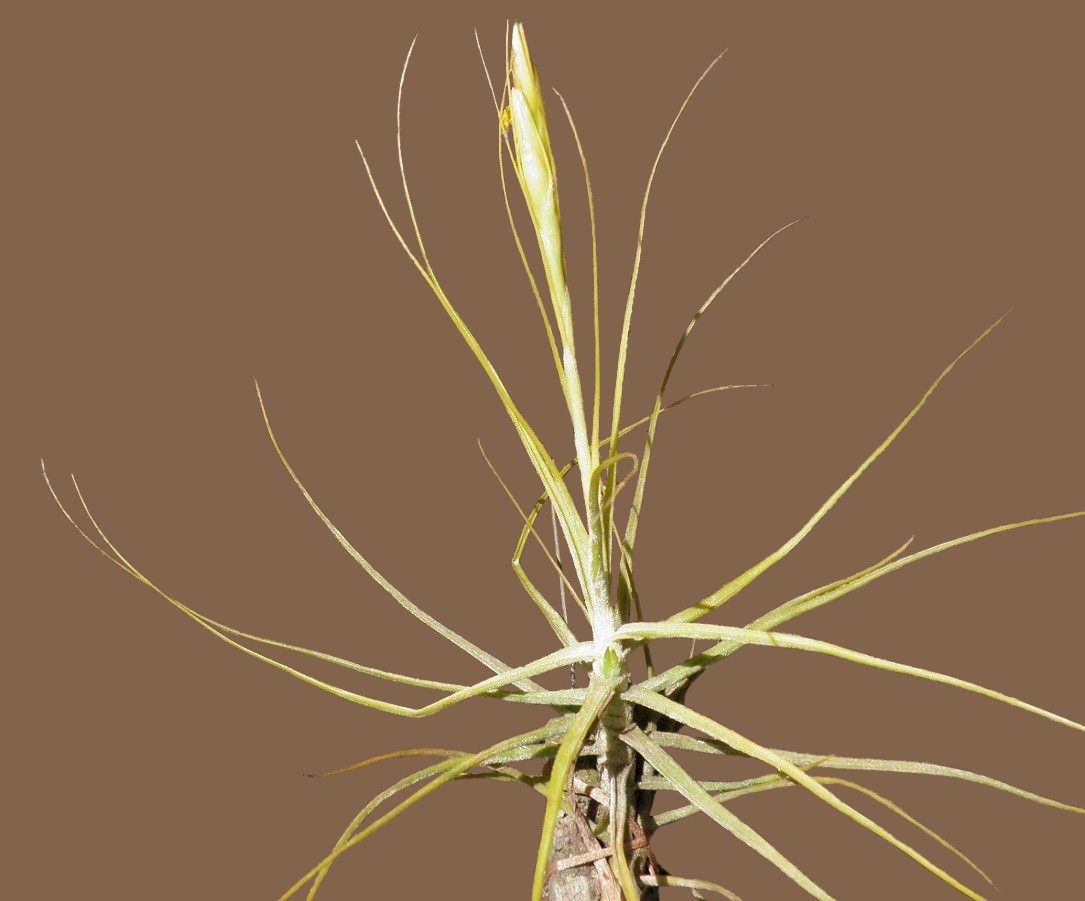
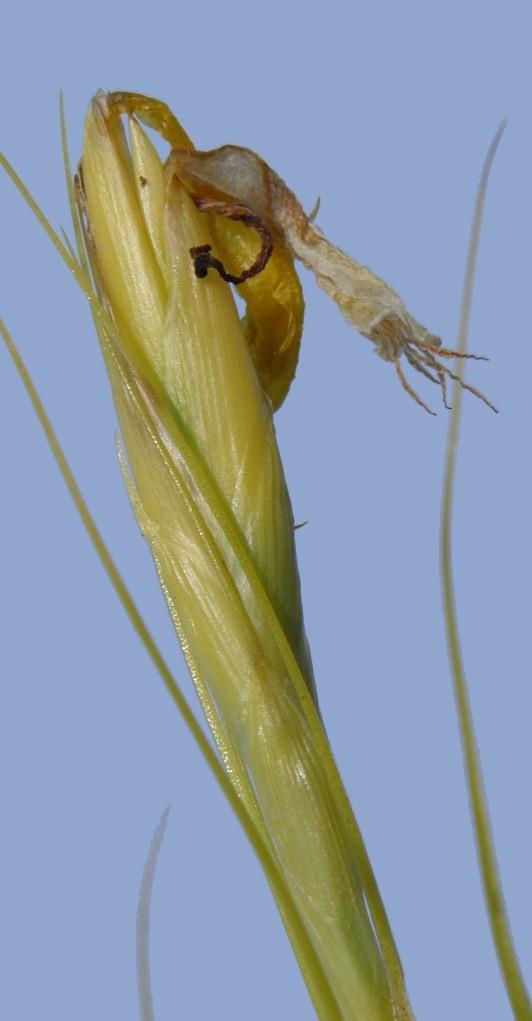
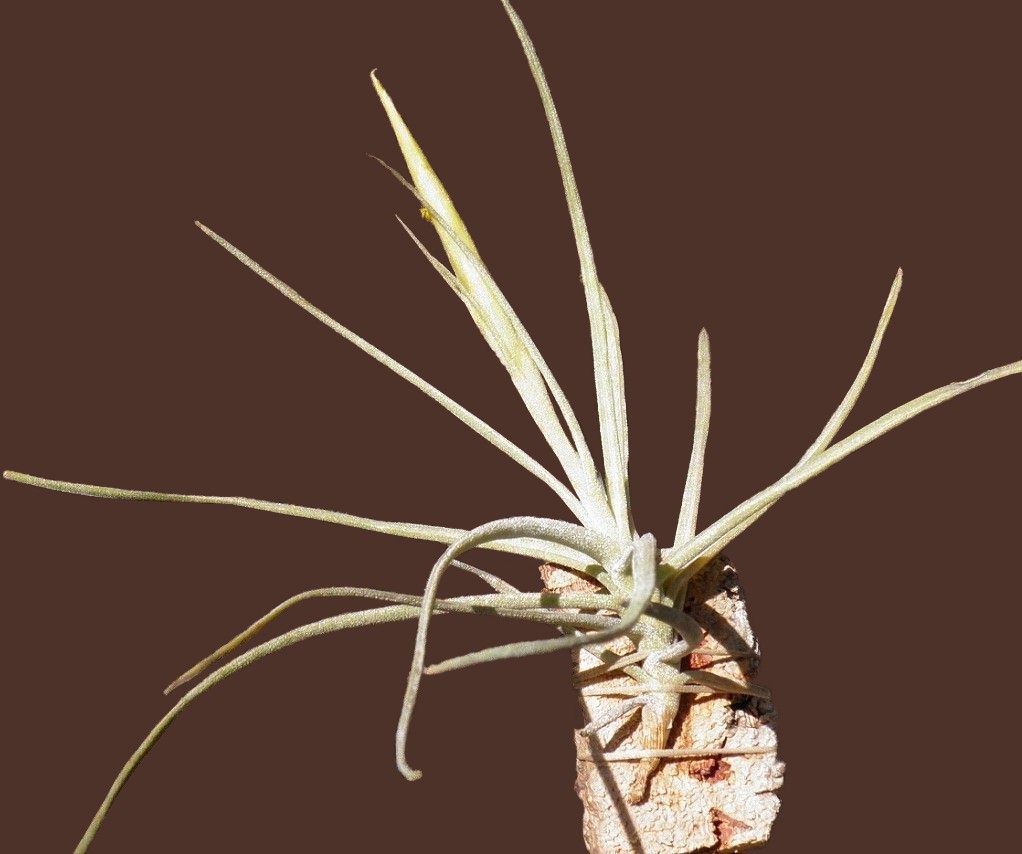
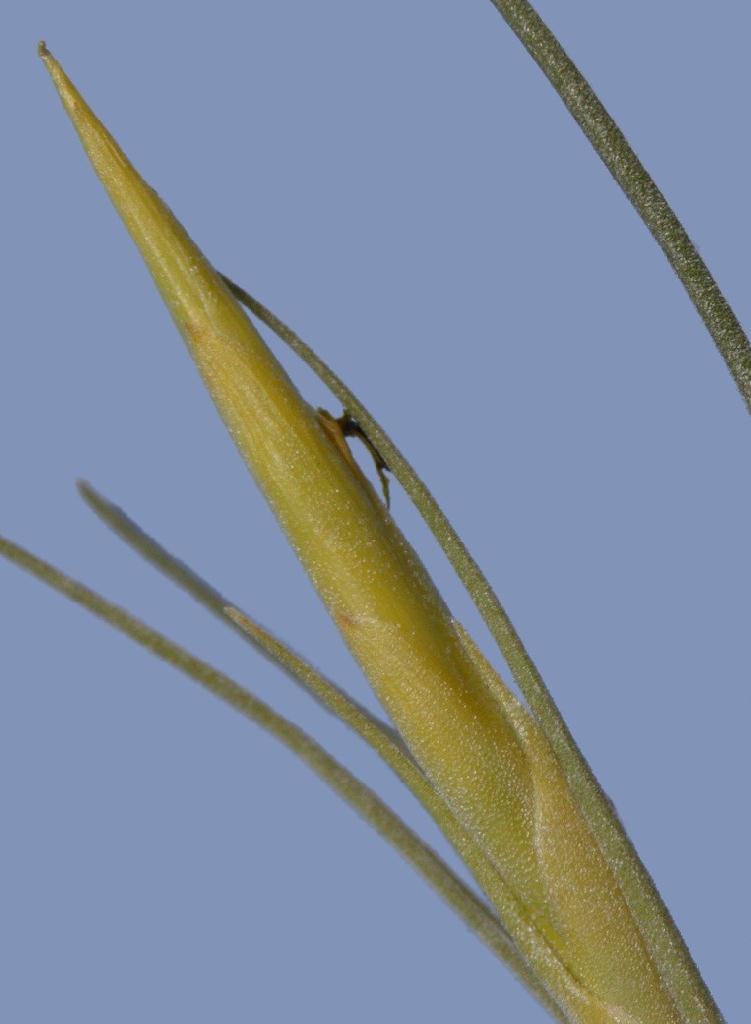
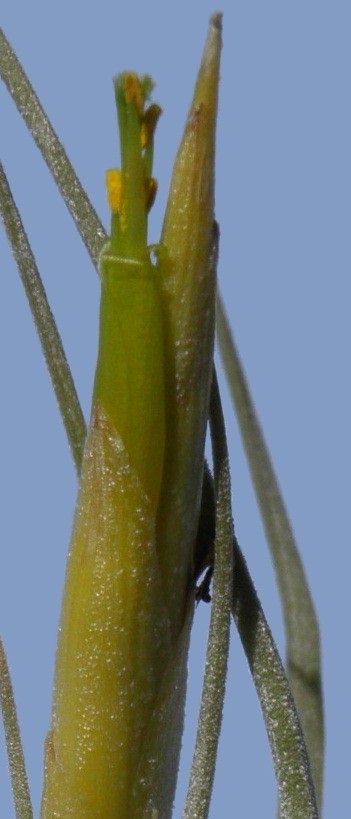
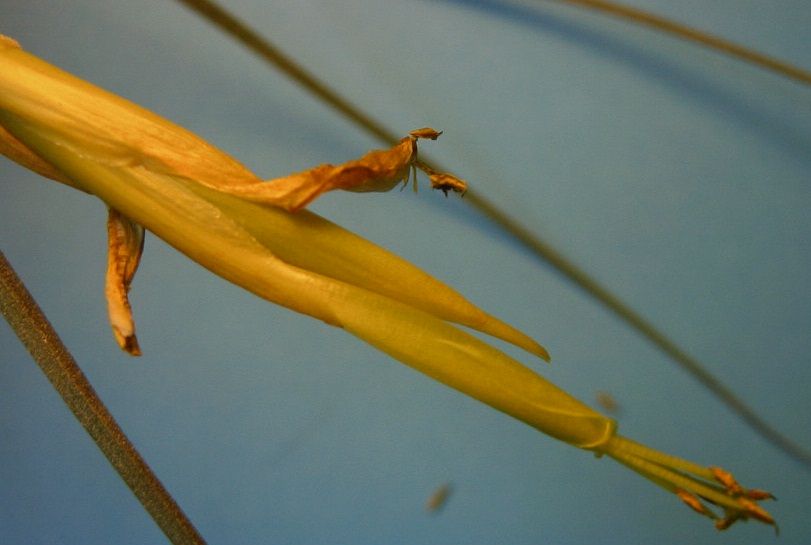
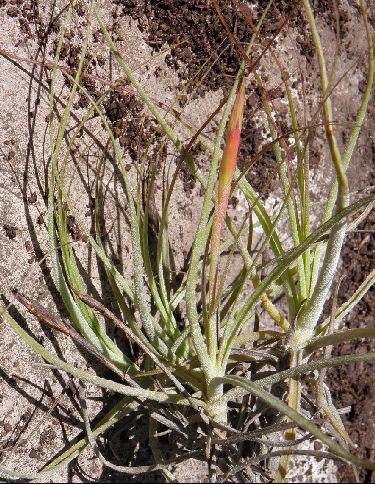
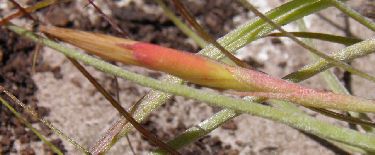
We now move to a plant that has the plant traits of a T. schiedeana and has reddish floral bracts but has cream flowers with pink speckles This is called ‘Speckled Pink’ (P26, 27 PHOTOS) and with leaves 5mm wide at widest, links more to the ‘Major’ form.
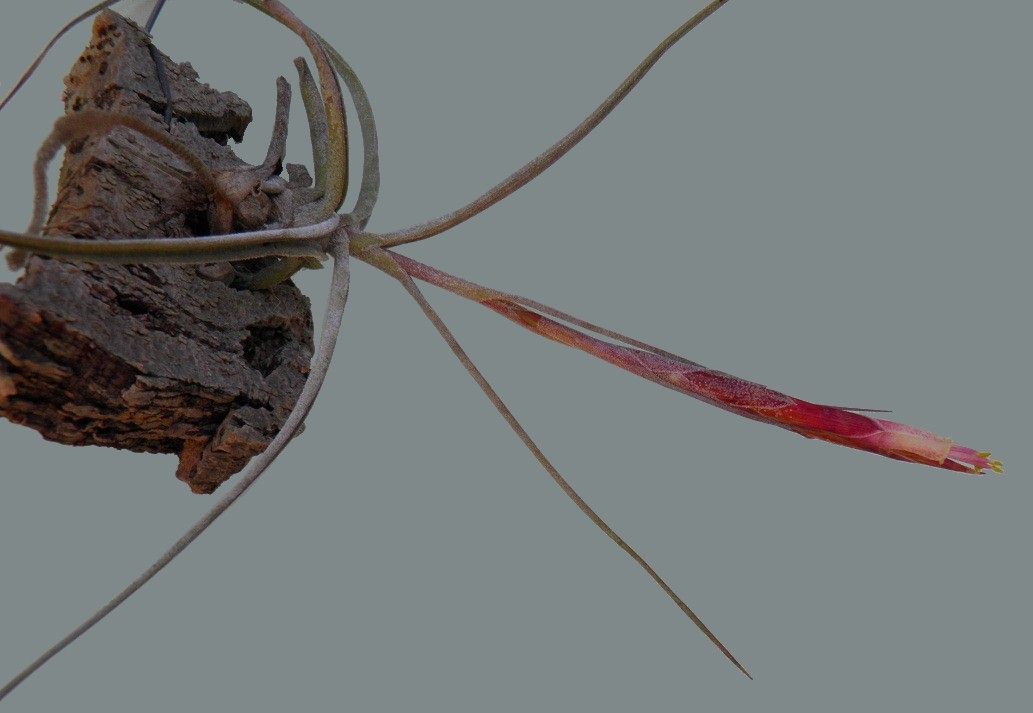
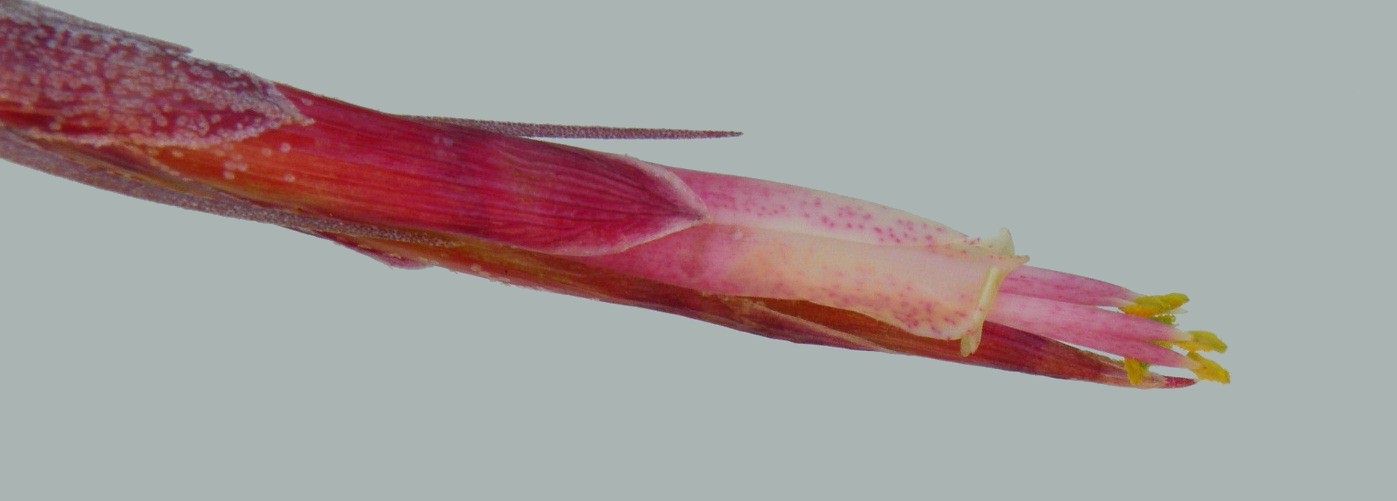
No moves have yet been made to give cultivar names to variants of T. glabrior.
For many years it was assumed by growers and keen collectors from the wild that any plant found in Mexico that had two coloured petals (namely white to yellow in the top half and reddish blue in the bottom half) just had to be a natural hybrid between a blue petalled species and T. schiedeana which achieved notoriety of being very promiscuous.
This belief caused much discussion before T. chapalliloensis (P 28, 29 PHOTOS) was published in J Brom Soc 61(4): 169-173. 2011. The following discussion from Renate Ehlers shows the decision to publish was not taken lightly.
“I originally obtained this Tillandsia in 1992 from my friend Jürgen Lautner, Goettingen, Germany, who discovered the plant on his trip to Mexico in 1992. He thought this was a new species which I should describe. But when I saw the flowers, I was nearly certain, that it was a hybrid. The two-coloured petals seem to be a sign of hybrid origin. Juergen insisted that this plant is very common near Chapalilla and that he did not see any putative parents for a hybrid. – But I did not trust him! Nevertheless I made a description which I gave Dr. Walter Till in May 1992. He commented that he thinks this is a hybrid between T. juncea and T. schiedeana. (P 30 PHOTO) I told Juergen his opinion which I shared, and that I cannot publish his plant as it is a hybrid. The plant grew very well in our collection and flowered several times. And Juergen had many little tillandsias growing pretty well from seed in the Botanical Garden in Goettingen and in his own collection.
In 2004 I was on a trip in Mexico with Juergen and Ulrich Lautner, Manfred Kretz and Wolfgang Schindhelm. On February 18th, we were driving from Puerto Vallarta in direction of Tepic on the MEX 15, and we intended to go to the area where Juergen found his dubious plant, and I was very curious. About 18 km before we reached Chapalilla, we saw the trees coated with many tillandsias. I really was very, very surprised when I saw, that this was THE PLANT, growing here by the thousands. It was not the same place where Juergen had collected his plants in March 1992, only the same area. The trees were crowded with the tillandsias, mostly growing in big clumps, but there also were single plants. We also found a few T. pseudosetacea, T. achyrostachys and T. makoyana and rarely T. ionantha.
The plant is growing in large numbers in this region, not only restricted to one location. There was not one T. schiedeana STEUDEL nor T. juncea SWARTZ growing at this location, and as well, we did not see any in the wider area. At the place where we collected, I would guess there were thousands of T. chapalillaensis, hundreds of T. pseudosetacea, tens of T. makoyana and T. achyrostachys and few T. ionantha.
Now I had to admit that Juergen Lautner was right: the plant is not a hybrid but a good new species. Maybe, or more likely, the plants are of hybrid origin. When a plant has densely populated a large area in such huge numbers and is fertile, it should be treated as a species, not as a hybrid. In the meantime, Juergen Lautner has adult seedlings from seed he collected in 1992, that flowered in the Botanical Garden of Goettingen several times, and they all look alike. He gave this plant to many other Botanical Gardens and collectors of bromeliads. They all flower every year and no other tillandsia brings so many fertile seeds, in my collection all plants growing in the surrounding of T. chapalillaensis often are covered with seeds.
Juergen and I had many discussions with friends about the plant and tried to solve the problem as to whether it is a hybrid or a species. Hiroyuki Takizawa wrote that he thinks that the putative hybrid on page 109 of the New Tillandsia Handbook by Hideo Shimizu and Hiroyuki Takizawa is the same plant as T. chapalillaensis, and I agreed that it looks similar. He got the plant from Alfredo Lau without location. But I believe that the plant shown on page 109 is closer to a hybrid that we found in the Sierra El Tuito. This is recorded in the Natural hybrids data base on http://fcbs.org as T. schiedeana x query. (P31 – 33. PHOTOS) Derek Butcher did a lot of investigation of hybrids, and just now in the wintertime he sent photos of putative T. schiedeana-hybrids to me for discussion, and so he made me start working again and finishing the article.
And I think, the Journal is the best place to publish the plant. We give the exact locality, where the plant is growing, hoping that some other collectors who come to this area, may be going to Puerto Vallarta, will take the chance to check, and may be they can write about their impressions in THE JOURNAL some day. And maybe there will be some more discussion about the evolution of a species and when is it classified as a natural hybrid.
After checking the description and history of T. chapalillaensis Hiro Takizawa commented: “I guess there are many natural hybrids amongst Tillandsia which are believed to be species. Natural hybridizing is a part of evolution. When does a hybrid become a species?" This is an interesting question and not easy to answer. A large population is important, especially for consideration as a species. Maybe some hybrids grow better than the parents and make large populations. Then it becomes a species!
Eric Gouda also contributed to the discussion. He has a number of seedlings from the Botanical Garden Goettingen from the first collection in 1992 of Jürgen Lautner, and so he was able to study the plant. He suggested that there seems to be slight differences in the seedlings but agreed to treat it as a species, as it has such a large population.”
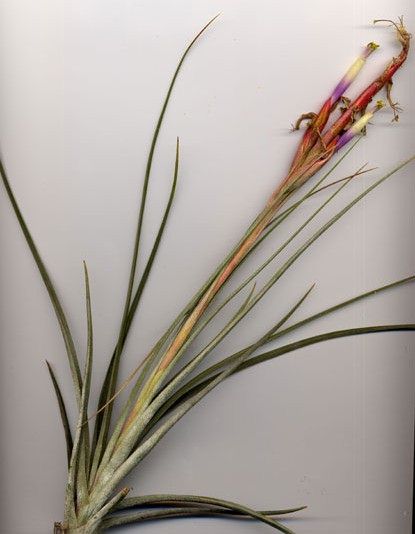
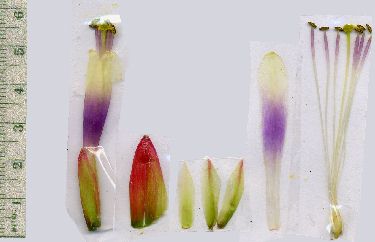
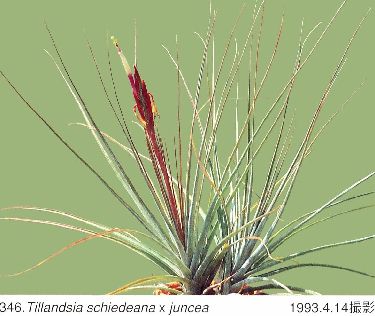
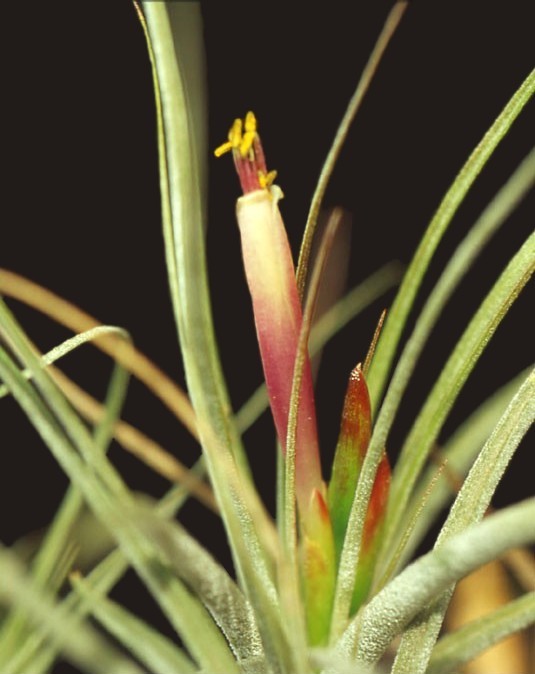
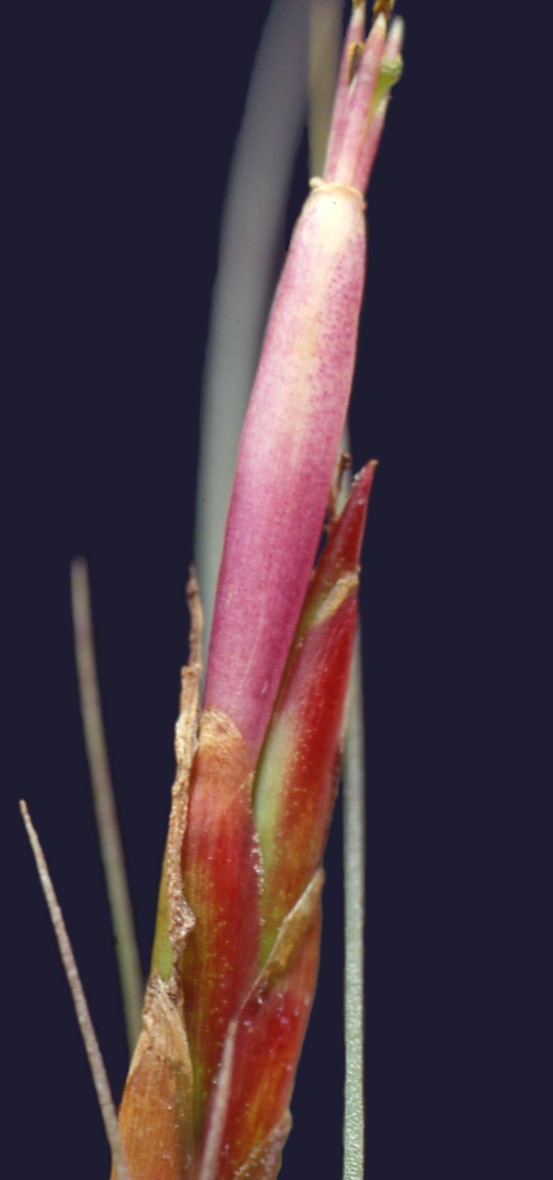
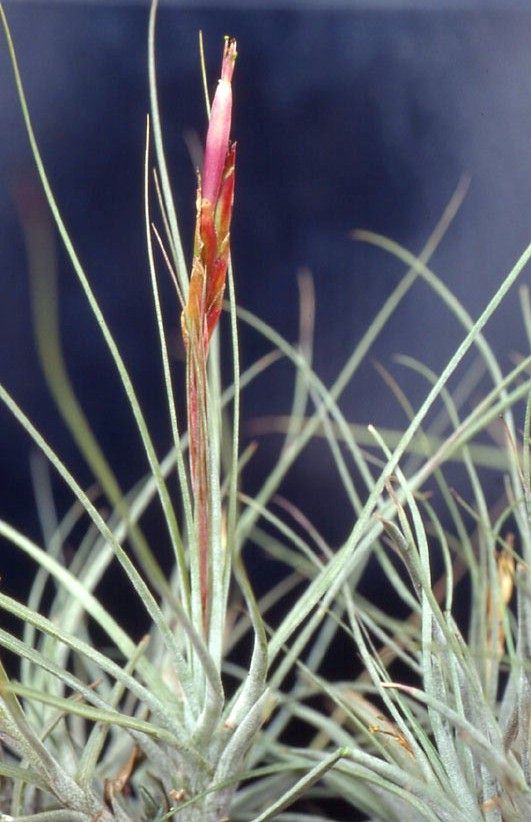
The mention by Walter Till that it could be (juncea x schiedeana) takes us to the early 1990’s when Rolly Reilly of Brisbane was hybridising tillandsias where one was called ‘Tooshi’. (P 34, 35 PHOTOS)
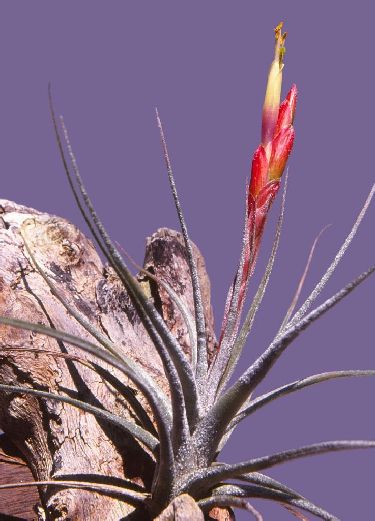
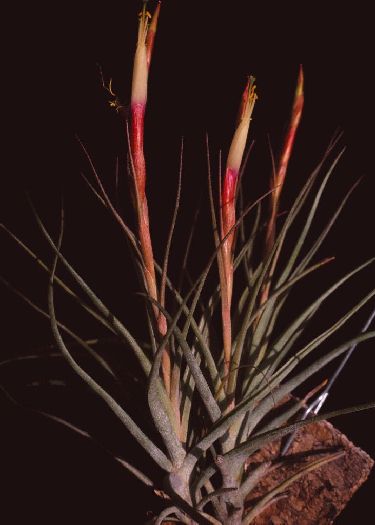
This in turn leads us to ‘Sesca’ where guessing the natural parents of T. baileyi and T. schiedeana seems to have gone astray. See below for the story.
“Tillandsia ‘Sesca’ by D Butcher 11/2011 (P 36, PHOTOS)
This intriguing saga started with my querying that ‘Sesca’ was in fact a hybrid and not a species based on recent revelations that Renate Ehlers was involved with a species found in Mexico that too had a bicolored flower (whitish top half purplish bottom half). This has been published under the name Tillandsia chapalilloensis, has a wide collection area and breeds true from seed. I was also investigating the same sort of claim of breeding true from seed from a similar plant with bicolored flowers that had been obtained by the Brisbane Botanic Gardens from Germany called (schiedeana x baileyi) but alas without further provenance. This will be referred to as BBG (P37, 38. PHOTOS) in the following discussions.
First we have what is recorded in the Bromeliad Cultivar Register
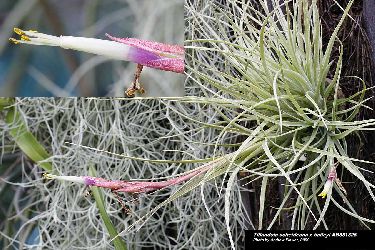
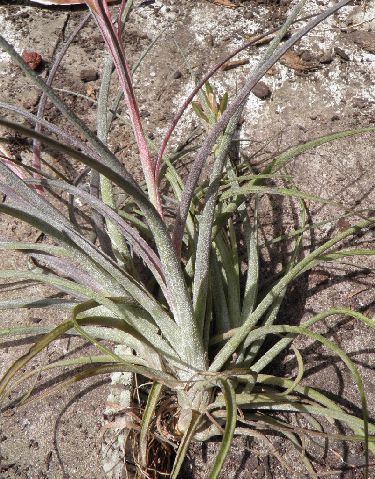
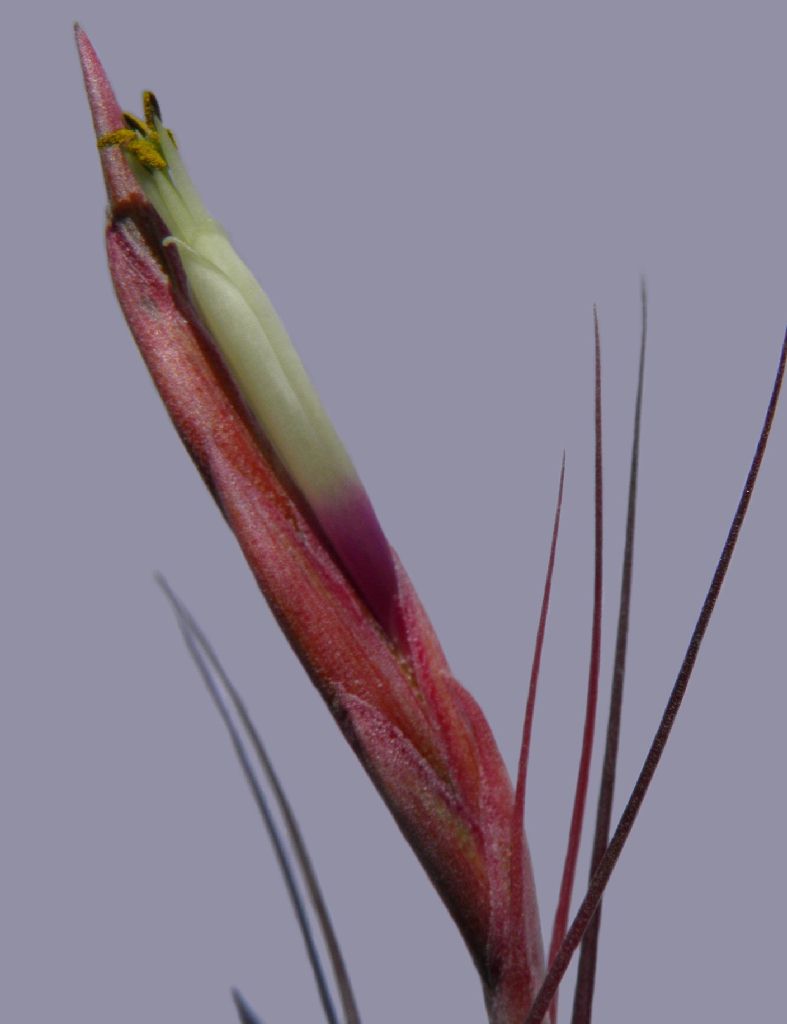
TILLANDSIA 'Sesca’ - Gouda E. Flower A* - ca. 2000
Country of origin: Holland /New Zealand. Seed Parent: schiedeana, Pollen Parent: baileyi
Grown by Anwyl Bromeliads (Andrew Flower), New Zealand, from seed supplied by Eric Gouda, Holland,. Seed sown June 1st 2000, First bloom date Jan 15 2009. Reg. Doc. by A Flower 6/2011
Investigation has shown that the seed did not come from a direct crossing of T. schiedeana with T. baileyi but was from a plant thought to be itself a hybrid (schiedeana x baileyi) In other words an F2 generation which we know from the study of genetics, should have many different looking progeny! It was revealed that the plant had been grown by Peter Bak as species number 37.
Alarm bells started ringing because of the similarity to the claim by the Germans regarding BBG.
I maintain that the name ‘Sesca’ should prevail for the BBG clone and progeny and Bak #37 for the simple reason we have very little provenance. Peter Bak reveals that Bak #37 was collected, according to his records, somewhere in Costa Rica at some time in the past. Therefore, the guessing of the involvement of T. baileyi (which is only reported from Texas or the adjacent Mexican border) is in error and we are dealing with a plant that has species attributes. A pollen count will be made at next flowering which won’t help us solve the remote possibility of the involvement of another species.
There are links to T. chapalilloensis which could easily have been found years ago but was summarily treated as a hybrid because we know of the promiscuity of T. schiedeana in the wild and that any plant found in the wild with bicolored petals MUST be a natural hybrid. This in turn links to one with even less provenance but grown in Australia - T. ‘Scurfy’!
Comparisons can also be drawn with T. floridana which also breeds true from seed from the specimens held in captivity!
So, perhaps we can get anyone who is collecting in Costa Rica to keep an eye out for a plant that has a similar growing habit to the ubiquitous T. schiedeana to look a bit closer and report back to the BSI.
In the meantime, we will be amending ‘Sesca’ in the Bromeliad Cultivar Register to be a cultivar rather than a hybrid!”
Tillandsia ‘Scurfy’ by Derek Butcher Jan 2009 (P38a,b,c PHOTOS)
“This all started in 2006 when Len Colgan got some plants from Renate Ehlers called T. chapalillaensis and I was lucky to get one of them.
2009 saw my plant flower and yes it had bicolored petals but it kept bugging me that I had seen this plant before and yes I found it - called T. schiedeana ‘Scurfy’ that I had got from Maurice Kellett in 1990.
Maurice can find no record of why he gave this name to the plant and I do not believe there is any link with the Australia man-made hybrids. It is just as likely that this plant came to Australia when he collected with Lau in the 1980’s. That way I can see tenuous links to T. chapalillaensis but not enough to change the name. Thus the name T. ‘Scurfy’ should be registered and if any of you are growing this ‘schiedeana’ with bicolored petals please change the name”
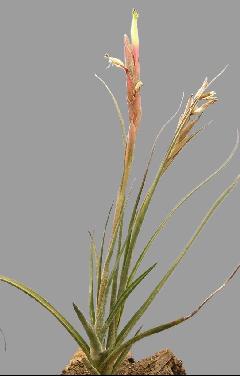
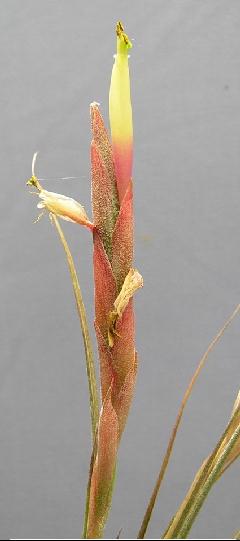
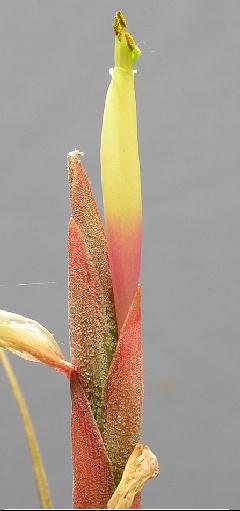
We now move away from forms to reported hybrids both natural or man made. The formula is in alphabetical order and not the man-made hybrid convention where seed parent comes first. These are all primary hybrids and with the man-made ones you can expect some consistency in looks. When found in the wild you do not know how much back crossing has occurred but then if only one collection has been made and offsets distributed, growers may not be aware of this variability. Also in some cases it was only alleged that the plant had been found in the wild, and putative parents allotted, and a cultivar name given later.
| baileyi x schiedeana | ‘Rosalie Mavrikas’ | 39, 40 |
| bartramii x schiedeana | ‘Candela’ | . |
| bartramii x schiedeana | ‘Pixie’ | 41 |
| bartramii x schiedeana | Natural hybrid | . |
| brachycaulos x schiedeana | ‘Laurie’ in Australia. Was it man-made? | 42 |
| brachycaulos x schiedeana | ‘Starburst’ in USA | 43 |
| brachycaulos x schiedeana | Natural hybrid | 44, 45 |
| caput-medusae x schiedeana | ‘Bruce Aldridge’ | . |
| disticha ‘Minor’ x schiedeana ‘Minor’ | ‘Two Minors’ | . |
| ehlersiana x schiedeana | ‘Peltry Jellyfish’ | 46, 47 |
| ehlersiana x schiedeana | Natural hybrid ? | . |
| fasciculata x schiedeana | Natural hybrid Koide’s TX017 | 48, 49 |
| fasciculata x schiedeana | Natural hybrid | 50 |
| glabrior x pueblensis | Natural hybrid Koide’s TX059 | 50a, 50b |
| ionantha x schiedeana | ‘Dawn’ | 51, 52 |
| ionantha x schiedeana | ‘Jack Staub’ | 53 |
| ionantha x schiedeana | rectifolia natural hybrid | 54, 55 |
| juncea x schiedeana | ‘Little Star’ | . |
| juncea x schiedeana | Natural hybrid ? | . |
| rodrigueziana x schiedeana | ‘Tiki Torch’ | . |
| schiedeana x ? | ‘Ivory’ | 56 |
| schiedeana x ? | ‘Taurus’ | 57, 58 |
| schiedeana x ? | Natural hybrid EM901603 Sierra El Tuito | . |
| schiedeana x ? | Natural hybrid EM8177 Sierra El Tuito | . |
| schiedeana x seleriana | ‘Bochil’ | 59, 60 |
| schiedeana x seleriana | Natural hybrid | 61, 62 |
